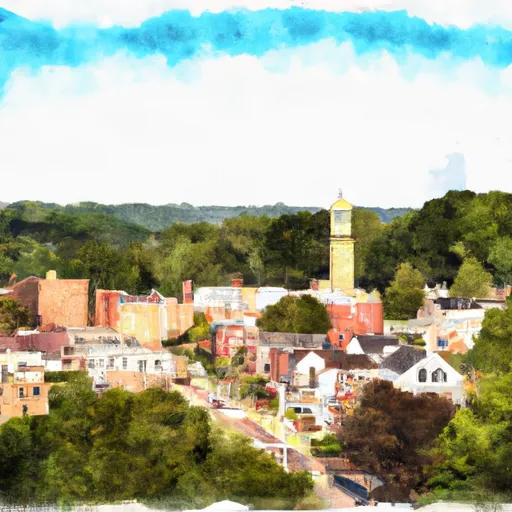-
 Snoflo Premium
Snoflo Premium
Get unlimited access to all our content
With no Ad interruptions! - Start Your Free Trial Login with existing account
Narberth
Eden Index
Climate
9.5
•
Recreation
6.0
•
Community
3.8
•
Safeguard
6.9/10

Narberth, Pennsylvania is a small borough located in Montgomery County, just outside of Philadelphia. The climate of Narberth is characterized by hot, humid summers and cold winters. Summers typically see temperatures ranging from the mid-70s to mid-80s Fahrenheit, while winters can be quite cold with temperatures often dropping below freezing.
When it comes to hydrology constituents, Narberth is not situated near any major bodies of water. However, it is home to several small streams and creeks that contribute to the local watershed system. These waterways, such as Mill Creek and Mill Run, provide important habitats for local wildlife and contribute to the overall ecological health of the area.
Narberth offers a variety of outdoor recreation opportunities for residents and visitors. The borough has several parks and green spaces, including Narberth Park, which features playgrounds, sports fields, and picnic areas. Additionally, nearby Valley Forge National Historical Park offers opportunities for hiking, biking, and exploring historical sites. For those interested in water-based activities, the Schuylkill River is within a short drive and offers opportunities for boating and fishing.
In conclusion, Narberth, Pennsylvania experiences a moderate climate, has a few local waterways, and provides various outdoor recreation options for its residents and visitors.
What is the Eden Index?
The Snoflo Eden Index serves as a comprehensive rating system for regions, evaluating their desirability through a holistic assessment of climate health, outdoor recreation opportunities, and natural disaster risk, acknowledging the profound impact of these factors on livability and well-being.
Climate Health Indicator (CHI): 9.5
Narberth receives approximately
1240mm of rain per year,
with humidity levels near 76%
and air temperatures averaging around
13°C.
Narberth has a plant hardyness factor of
7, meaning
plants and agriculture in this region tend to thrive during the non-winter months.
By considering the ideal temperature range, reliable water supplies, clean air, and stable seasonal rain or snowpacks, the Climate Health Indicator (CHI) underscores the significance of a healthy climate as the foundation for quality living.
A healthy climate is paramount for ensuring a high quality of life and livability in a region, fostering both physical well-being and environmental harmony. This can be characterized by ideal temperatures, reliable access to water supplies, clean air, and consistent seasonal rain or snowpacks.
Weather Forecast
Streamflow Conditions
Lower Delaware
Area Rivers
Lower Delaware
Snowpack Depths
Lower Delaware
Reservoir Storage Capacity
Lower Delaware
Groundwater Levels
Recreational Opportunity Index (ROI): 6.0
The Recreational Opportunity Index (ROI) recognizes the value of outdoor recreational options, such as parks, hiking trails, camping sites, and fishing spots, while acknowledging that climate plays a pivotal role in ensuring the comfort and consistency of these experiences.
Access to outdoor recreational opportunities, encompassing activities such as parks, hiking, camping, and fishing, is crucial for overall well-being, and the climate plays a pivotal role in enabling and enhancing these experiences, ensuring that individuals can engage in nature-based activities comfortably and consistently.
Camping Areas
| Campground | Campsites | Reservations | Toilets | Showers | Elevation |
|---|---|---|---|---|---|
| Tohickon Valley County Park | 22 | 377 ft | |||
| Tinicum County Park | None | 120 ft | |||
| Parvin State Park | 55 | 72 ft | |||
| Lake Towhee County Park | None | 509 ft |
Nearby Fishing
Nearby Ski Areas
Catastrophe Safeguard Index (CSI):
The Catastrophe Safeguard Index (CSI) recognizes that natural disaster risk, encompassing floods, fires, hurricanes, and tornadoes, can drastically affect safety and the overall appeal of an area.
The level of natural disaster risk in a region significantly affects safety and the overall livability, with climate change amplifying these risks by potentially increasing the frequency and intensity of events like floods, fires, hurricanes, and tornadoes, thereby posing substantial challenges to community resilience and well-being.
Community Resilience Indicator (CRI): 3.8
The Community Resilience Indicator (CRI) recognizes that education, healthcare, and socioeconomics are crucial to the well-being of a region. The CRI acknowledges the profound impact of these elements on residents' overall quality of life. By evaluating educational resources, healthcare accessibility, and economic inclusivity, the index captures the essential aspects that contribute to a thriving community, fostering resident satisfaction, equity, and social cohesion.

